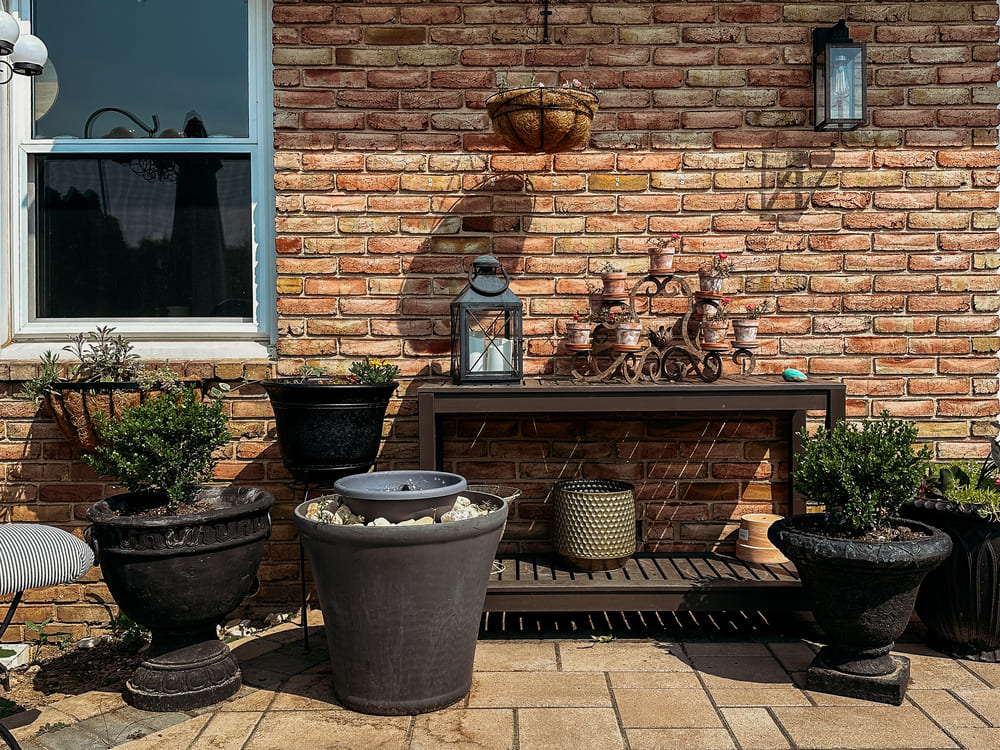If you have landscaping around your home, you probably have experience with mulch – the stuff we lay on top of the soil in our flower beds to cover weeds and make our beds look cleaner. I’ve been chatting with some landscaper friends who were more than willing to spill trade secrets that will help your mulch game and save you money in the long run!

This post contains affiliate links which might earn me a small commission at no cost to you.
THANK YOU for supporting me and the quality items I promote!
There are actually two categories of mulch, and while they can both have benefits, I’m focusing on money saving tips for Wood Mulch in this post, which is a type of Organic Mulch.
The Two Types of Mulch
Just a quick overview about the two different categories of mulch – Organic and Inorganic

1. Organic Mulch will break down with time and nourish your soil. It is made of living matter including
- Wood like pine bark mulch, hardwood mulch, wood chips, and cedar
- Pine Straw- dried out pine needles
- Grass clippings
- Leaf Litter
- Hay or Straw

2. Inorganic Mulch will prevent weeds from growing but will not enrich the soil like organic mulch. It is made up of nonliving materials such as
- Landscape Fabric
- Black Plastic Sheeting
- Rubber mulch
- Rocks/Stones/Gravel

What Are The Benefits Of choosing Organic Mulch?

- Reduces Weed Growth
- Regulates Soil Temperature
- Improves Soil Health
- Increases Growing Season
- Prevents Plant Diseases
- Retains Soil Moisture
I prefer the look of shredded pine wood mulch, which is more cost effective than hardwood or cedar mulch. But not all wood mulches are created equal. Here are some things to keep in mind.

How To Choose The Best Wood Mulch
1. Choose finely shredded mulch!
When you go with the chunky stuff, it has a very hard time breaking down, which is what we want mulch to do! As mulch breaks down, it adds nutrients to your soil, feeding your plants and improving their health! Finely shredded mulch also spreads easier and further meaning you end up needing less mulch. Hello, money saved!

2. Make sure it doesn’t include palette wood.
First of all, it loses its color very quickly. And second, palette wood is a breeding ground for artillery spores which will leave black dots all over the side of your home that are SUPER hard to get rid of.

3. Choose a reputable, local company.
Things like palette wood and poison ivy/oak are far less likely to be used in premium mulch from a local company. We end up spending more money on our mulch, but it’s a MUCH better choice to ensure our plants stay healthy. A simple search for a local landscape supply store will put you in the right direction!

3 Simple Tips For Wood Mulching
1. Lose the Plastic
This was a new tip for me! Don’t bother with the plastic sheeting made to lay down before mulching. Weeds will still penetrate the barrier as your much breaks down, and then it’s almost impossible to pull or dig them out! Don’t waste your money!

2. Don’t get too close
Don’t mulch up against your house. Keep about 6-8 inches between your mulch line and the house to prevent bugs like TERMITES from being encouraged to enter the walls. If you have a brick exterior like we do, it’s less likely but its’ still a much safer bet to keep that distance!

3. Break it up
I sound like a broken record with this tip, but every time I share it, I get a lot of feedback that it was new information! After mulch sits in your flower beds for a while, the sun begins to bake it and a crusty layer forms that acts as a barrier preventing water and light to get through to your plant babies and their roots!

Using a 4 prong cultivator, loosen the mulch at least in the spring, if not once a month to keep your mulch and soil loose. It helps your plants get what they need AND makes it much easier to pull those weeds that inevitably pop up.
Looking for more affordable and simple landscaping ideas? Start here!
xoxo, L



